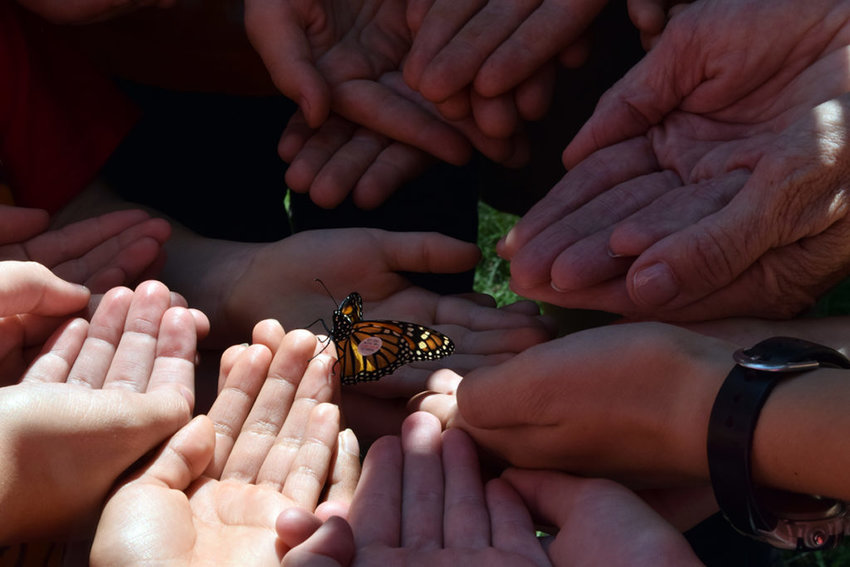 As instructed, hands are still to allow this newly emerged and tagged monarch to take flight. It is one of about 75 butterfly releases from the U of MN Monarch Lab during the festival.
As instructed, hands are still to allow this newly emerged and tagged monarch to take flight. It is one of about 75 butterfly releases from the U of MN Monarch Lab during the festival.
Article and all photos by JILL BOOGREN
An estimated 10,000 people came to Lake Nokomis under gloriously sunny skies for the Monarch Festival-Festival de la Monarca on Sept. 8. In its tenth year, the event celebrates the monarch butterfly’s 2,300-mile migration from Minnesota to Mexico through music, art, food, and dance.
With support from the Minnesota State Arts Board and Metro Regional Arts Council, ten different artists offered hands-on art-making opportunities.
Tents were abuzz with people painting, folding, gluing and pressing materials into monarch and caterpillar figures. Prints directed by Sol y Luna Gallery and Sarah Nassif hung on clothespins to dry, as did monarch-painted orange wings from In the Heart of the Beast Puppet & Mask Theatre (HOBT) and freshly-pasted piñatas from Yolanda Martinez. Kids showed off their felted caterpillars and hand puppets.
 Photo right: Enjoying elote grilled corn are (left to right): Mani Subramani, the twins Prema and Vasantha, and Vidya Subramani. At the back is Vaishnavi Subramaniam. From Edina, this was their first time at the festival.
Photo right: Enjoying elote grilled corn are (left to right): Mani Subramani, the twins Prema and Vasantha, and Vidya Subramani. At the back is Vaishnavi Subramaniam. From Edina, this was their first time at the festival.
Visitors came from all over the metro area, some “frequent flyers” of the festival, others there for the first time.
“It’s awesome,” said Shannon Johnson, of New Hope, who was there with her family for the first time. “There are so many activities for kids.” Accompanying Johnson was her husband, Derek, and kids, Daphne, Felix and Simon, whose faces she painted with colorful monarchs.
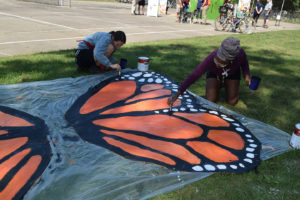 Photo left: Adriana Foreman (at right) and Dillon Sebastian of In the Heart of the Beast Puppet & Mask Theatre paint large butterfly wings and lay them out to dry on the tennis courts.
Photo left: Adriana Foreman (at right) and Dillon Sebastian of In the Heart of the Beast Puppet & Mask Theatre paint large butterfly wings and lay them out to dry on the tennis courts.
Monarch wings, many of them homemade and painted on cardboard or canvas, were a prominent feature of the costume parade, which made its procession to the stage where the Folwell Performing Arts Magnet Mariachi Band was performing De Colores and other favorites.
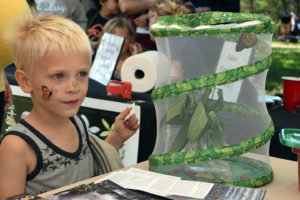 Photo right: Tennyson Meyers checks out a monarch in the butterfly tent at U.S. Fish and Wildlife’s conservation station.
Photo right: Tennyson Meyers checks out a monarch in the butterfly tent at U.S. Fish and Wildlife’s conservation station.
According to Stacy Aldrich, who teaches orchestra at the school, the band is comprised of 7th and 8th graders (at Folwell students begin learning string instruments in third grade). Some alumni joined them for the festival.
Music and dancing continued throughout the day. The masks, feathers, and capes worn by the Chinelos San Pablo Apóstol delighted their early morning audience, many of whom danced alongside the costumed performers. Later on, dancers with Ballet Folklorico Mexico Azteca dazzled the large crowd.
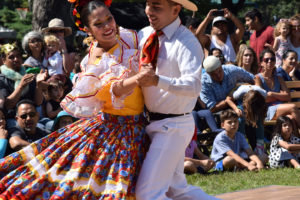 Photo left: Ballet Folklorico Mexico Azteca wow the crowd with traditional folk dancing.
Photo left: Ballet Folklorico Mexico Azteca wow the crowd with traditional folk dancing.
As always, there were opportunities to learn about monarchs. Tours of the Nokomis Naturescape Garden, a monarch waystation, offered a glimpse of the native plants that benefit monarchs.
The U.S. Fish & Wildlife Service (USFW) and MN Valley National Wildlife Refuge hosted the Monarch Butterfly Migration Art Shanty that was on Lake Harriet last winter. Layne Warner, of the Wildlife Refuge, presented inside the shanty as listeners colored and cut small pictures of monarchs to pin to a tree.
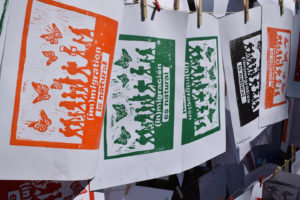 Photo right: At Sol y Luna Gallery people make prints that read in English and Spanish: (im)migration is natural - (in)migración es natural
Photo right: At Sol y Luna Gallery people make prints that read in English and Spanish: (im)migration is natural - (in)migración es natural
“Sometimes so many monarchs are on a branch it will fall off,” Warner said.
The University of MN Monarch Lab education tent showed visitors the life cycle of butterflies. With small groups gathered outside, they tagged and released about 75 butterflies throughout the day.
 Photo left: Lennox White, 17 months old, enjoys her first monarch festival by dancing with the Chinelos San Pablo Apóstol.
Photo left: Lennox White, 17 months old, enjoys her first monarch festival by dancing with the Chinelos San Pablo Apóstol.
While monarchs reigned supreme, other pollinators were featured too. Kids scrambled across the field in a monarchs-versus bees soccer matchup, and the USFW had a station for people to fill and color their own seed packets to benefit the endangered Rusty Patched Bumble Bee.
“The Twin Cities is one of a few places the Rusty Patched Bumble Bee is found,” said Tam Smith of USFW.
Visitors also bought monarch-friendly native plants and ate elote (grilled corn traditionally served with chili-spiced mayo) and treats from a dozen different food trucks.
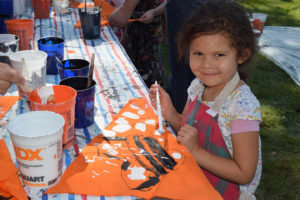 Photo right: Kaylee McDonald of St. Bonifacius paints a monarch wing during her first trip to the festival.
Photo right: Kaylee McDonald of St. Bonifacius paints a monarch wing during her first trip to the festival.
The event was hosted by the Minneapolis Park and Recreation Board in partnership with Nokomis East Neighborhood Association.
Comments
No comments on this item Please log in to comment by clicking here